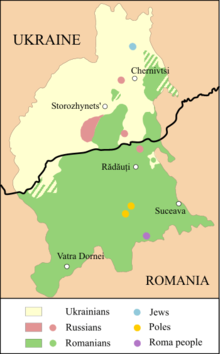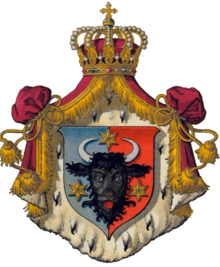Bukovina
![]()
The title of this article is ambiguous. For other meanings, see Bukovina (disambiguation).
Bukovina (IPA: ˌbukɔˈviːnaː, ![]() German also Buchenland; Romanian Bucovina, Ukrainian Буковина Bukovyna) is a historical landscape in the border region between Central, Southeastern and Eastern Europe. The northern half belongs to Ukraine and is part of Chernivtsi Oblast. The southern half belongs to Romania and is part of Suceava County. This is also the location of the Moldavian Monasteries, which are a UNESCO World Heritage Site. Bukovina, like Bessarabia to the east, was part of the historic Principality of Moldavia for centuries; from 1775 to 1918 the area with its multi-ethnic population belonged to the Habsburg Monarchy. To the northwest lies Eastern Galicia, to the southwest Transylvania.
German also Buchenland; Romanian Bucovina, Ukrainian Буковина Bukovyna) is a historical landscape in the border region between Central, Southeastern and Eastern Europe. The northern half belongs to Ukraine and is part of Chernivtsi Oblast. The southern half belongs to Romania and is part of Suceava County. This is also the location of the Moldavian Monasteries, which are a UNESCO World Heritage Site. Bukovina, like Bessarabia to the east, was part of the historic Principality of Moldavia for centuries; from 1775 to 1918 the area with its multi-ethnic population belonged to the Habsburg Monarchy. To the northwest lies Eastern Galicia, to the southwest Transylvania.

Location of Bukovina between Ukraine and Romania

Coat of arms of the Duchy of Bukovina
Name
The term "Bukovina" comes from the Slavic languages and refers to an area forested with beech trees (buk = beech). Especially in the West Slavic area it is widely used as a toponym. The term was also adopted by the Romanian language during the Middle Ages, and several beech-rich areas in the Principality of Moldavia were named as bucovină, including the area later annexed by the Habsburgs. The coat of arms of the crown land of Bukovina was created on the basis of the Moldavian coat of arms.
See also: "The Moldavian aurochs" in the article: Principality of Moldova
Geography
In 1900, the Duchy of Bukovina covered 10,441 km² and had 730,000 inhabitants.
The landscape borders on the Carpathians in the southwest. The transition to Transylvania is formed by the Tihuța Pass, formerly known as the Borgo Pass. In the Carpathians rise the rivers Siret and Moldova. The countryside and principality of Moldova are named after the Moldova. In the north the country changes into the plain and reaches up to the Dnister. The Pruth, Romania's eastern border river, also flows through Bukovina.
The climate of the country was described in 1895 as "healthy but harsh", the average annual temperature in Chernivtsi was given as 8.3 °C, in the higher parts of the country as 5.6 °C, the average annual precipitation as 580 mm.
Search within the encyclopedia